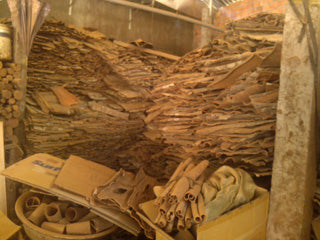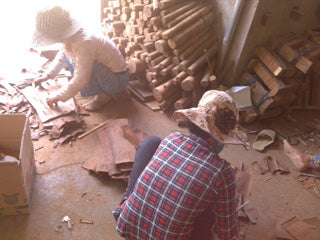OWP
Hand-Made Cinnamon Bark Holiday Ornament - Peace Dove- Fair Trade-Vietnam
Hand-Made Cinnamon Bark Holiday Ornament - Peace Dove- Fair Trade-Vietnam
Couldn't load pickup availability
These unique Peace Dove ornaments made of aromatic cinnamon bark from Vietnam will fill your home with the warm scent of cinnamon this holiday. The Cassia or cinnamon trees that are used to produce these ornaments are a renewable resource and are sustainably harvested by Vietnamese artisans.
- Measures 2” high x 2 1/2” wide x 1/8” deep
Handmade in Vietnam and fair trade imported.
Famous for spice, Cinnamon is obtained from the dried inner bark of an evergreen tree that belongs to the Cinnamomum genus. During ancient times, cinnamon was considered a precious possession and was often given as a gift to kings or gods. Historical evidence claims that cinnamon was presented at the temples of the Greek & Roman gods Apollo and Miletus. In modern times, cinnamon is used as a very important spice/condiment in various cuisines across the world.
Cinnamon is yielded by growing the tree for 2-3 years and then coppicing it. Coppicing, a traditional method of woodland management, is the process of cutting the tree to the ground level and allowing it to grow again. The trees naturally reshoot from their stumps or roots, thus the tree is unharmed and regains its matured size. Cinnamon trees can yield productive barks for about 45 years, after which they are required to be replaced with a new seedling. Coppicing becomes an environmentally sustainable way to harvest cinnamon bark over and over from the same tree.
To learn more about the artists and their techniques used to create these eco-friendly holiday ornaments, click on "About the Artisans".
Share
About the Artisans
About the Artisans
 Joyeria Semilla meaning Seed Jewelry is a small fair-trade workshop in the Andean town of Villa de Leyva, Colombia. Girasol Taborda, a local artisan and social entrepreneur, started the workshop in the mid-1990s.
Joyeria Semilla meaning Seed Jewelry is a small fair-trade workshop in the Andean town of Villa de Leyva, Colombia. Girasol Taborda, a local artisan and social entrepreneur, started the workshop in the mid-1990s.
Joyeria Semilla’s objective is three-folds; to create new jobs, revive Colombia's handicrafts sector and to motivate locals to better manage their natural resources. The organization works primarily with socially and economically disadvantaged youths, single mothers and people with disabilities in the area. The company offers free training in product design, technical training and marketing to new members. Joyeria Semilla has trained them in the craft of jewelry-making.

Caña Flecha or “Gynerium Sagittatum” is a locally found palm tree in the regions of the Caribbean coast. The leaves from this plant are used for making jewelry, woven hats, bags and baskets. The Zenú Indians were and their descendants inherited the tradition of picking veins of the green palm leaf for weaving. These veins were made into woven hats and other products for their personal use.
The Zenú culture is said to have existed between 200BC to1600AD. With the arrival of the colonizers in the 16th century, the indigenous community declined of unknown reasons. Today a very small population remains that claims the inheritance of the almost extinct Zenú tribe. Known for their skills in the construction of major waterworks, canals and irrigation system along with being skilled goldsmiths, examples of their accomplished craftsmanship are found in various museums around the world. Their larger means of subsistence were hunting, farming, fishing and trading.
Caña Flecha is found in abundance in the region, and hence makes for a sustainable and naturally available raw material for these products. Every bit of the plant is utilized – from using in building walls and roofs in houses to food for cattle and medicinal purposes. It is from the central vein of the leaf that the fibers for weaving are obtained. After the hard surface is peeled off, the fibers are left in the sun to dry and undergo a natural tinting process; these fibers are barely about 1 millimeter in thickness and hence call for a lot of skill and patience to weave with. The dried fibers are then processed for natural coloration - some are boiled with lemon to whiten them and some are treated with mud and boiled with plantain leaves to blacken them. The designs are based on ancient motifs and mathematical representations, which are inspired by the early Zenú culture.






